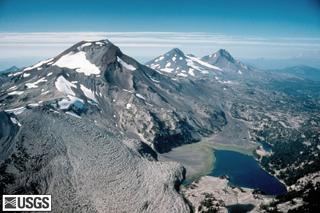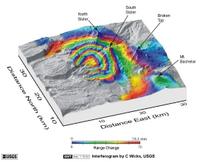 Firstly, I'm not sure why this is such a big deal. I've known about this for several years now and I'm quite confident it's been reported on in the MSM before. Why it's suddenly news worthy of being repeated in multiple major news outlets, I don't know.
Firstly, I'm not sure why this is such a big deal. I've known about this for several years now and I'm quite confident it's been reported on in the MSM before. Why it's suddenly news worthy of being repeated in multiple major news outlets, I don't know. So, where is all the excitement located? The Three Sisters are located in central western Oregon and are essentially due west of Eugene. They are part of the Cascade Range. This is the mountain range that Mt. Hood, Mt. St. Helens and Mt. Rainier are all part of. All volcanic activity in this range is a result of the subduction of the Juan De Fuca plate underneath the North American plate.
So, where is all the excitement located? The Three Sisters are located in central western Oregon and are essentially due west of Eugene. They are part of the Cascade Range. This is the mountain range that Mt. Hood, Mt. St. Helens and Mt. Rainier are all part of. All volcanic activity in this range is a result of the subduction of the Juan De Fuca plate underneath the North American plate.The area around the Three Sisters is different from the many of the other peaks of the Cascade Range in that there are a large number of distinct volcanic features such as cinder cones, eruptive lava flows and craters, in addition to the three main peaks, in a fairly small area. The three peaks themselves are an anomaly in that they are literally three distinct stratovolcanoes within very close proximity. Normally, hundreds of miles separate the major stratovolcanoes of the Cascades. So, there may be or may have been something different about the magma and crust underneath the Three Sisters, but no one really knows. While the area has been very volcanically active in the past, it's rather quiet now when compared to some of the other Cascade peaks. It's difficult to learn about a volcano when there's nothing really going on.
 The uplift that's occurring in the area near the three sisters was only detected recently because of the development of a new technique that allowed them to see very small uplift like this. Uplift is being tracked at other volcanoes around the world such as Mauna Loa, but uplift like that occurring in Hawaii is easier to see by virtue of it occurring in an area where one would expect to see it, and thus is more easily detected using older conventional methods. At least, that's my understanding. This new technique (InSar) essentially uses two separate batches of radar data (in this case one from 1996 and the other from 2000) to create an interference pattern that indicates the height difference between the two time periods. How this technique works, I don't really understand beyond this.
The uplift that's occurring in the area near the three sisters was only detected recently because of the development of a new technique that allowed them to see very small uplift like this. Uplift is being tracked at other volcanoes around the world such as Mauna Loa, but uplift like that occurring in Hawaii is easier to see by virtue of it occurring in an area where one would expect to see it, and thus is more easily detected using older conventional methods. At least, that's my understanding. This new technique (InSar) essentially uses two separate batches of radar data (in this case one from 1996 and the other from 2000) to create an interference pattern that indicates the height difference between the two time periods. How this technique works, I don't really understand beyond this.When geologists first discovered that the uplift had happened, they were unclear on whether or not it was a single event or something that continues to occur. Data gathered since 2000 indicates that the uplift has continued and that the total height increase is about 10 inches at this time. Although the news release seen in the MSM said that this uplift could be caused by water or magma, it seems more likely that it's occurring because of the intrusion of a small amount of magma. I say this not because I'm personally an expert on what's going on in the area, but I do know that the gelogists studying the uplift have performed some isotopic analysis of the gasses coming out of the ground in the area, and the isotopes of carbon and helium being encountered are those typically found in conjunction with magma.
By "a small amount of magma" they mean about 40 million cubic meters. That would be a cube approximately 342 meters (1122 ft) on a side. As has been reported, the pool of "fluid" is about a mile across and 65 feet deep or so. Of course, when magma does reach the surface and erupt as lava, the volatiles previously trapped in the fluid by the high pressures encountered underground are free to expand and the volume of material greatly increases. Still, during an eruption, it's rare that a magma chamber or pool is substantially emptied out.
 In march of 2004 the area near the uplift (which is normally pretty quiet by Cascade standards) experienced a small swarm of earthquakes. This swarm of earthquakes could have presaged the beginning of a volcanic eruption, but didn't. It's more likely that stress induced in the surround rock from the uplift (try imagining the amount of force necessary to squirt hot toothpaste into basalt) was being relieved by the fracture and shift of rocks around it. This is, of course, how hot rising magma manages to force it's way to the surface. It's interesting though, to compare the increased seismic activity from this uplift in the Three Sisters area with the normal seismic activity occurring at a dormant volcano like Mt. Rainier.
In march of 2004 the area near the uplift (which is normally pretty quiet by Cascade standards) experienced a small swarm of earthquakes. This swarm of earthquakes could have presaged the beginning of a volcanic eruption, but didn't. It's more likely that stress induced in the surround rock from the uplift (try imagining the amount of force necessary to squirt hot toothpaste into basalt) was being relieved by the fracture and shift of rocks around it. This is, of course, how hot rising magma manages to force it's way to the surface. It's interesting though, to compare the increased seismic activity from this uplift in the Three Sisters area with the normal seismic activity occurring at a dormant volcano like Mt. Rainier.In the end, it's possible that the uplift may result in a volcanic eruption. Or, the intrusion of magma may stop and the hot material will simply sit there four miles underground and slowly cool off. With volcanoes, it's very difficult to predict what will happen over long periods of time, except in the sense of very long term trends. Even if there is an eruption, it's unlikely to be particularly large. After all, 40 million cubic feet is apparently a small amount of magma. Since there are very few people living in that area and the warning signs of an iminent eruption will be obvious for months before hand, it's not likely to be dangerous to anyone.

1 comment:
Well, I raked a bunch of them up today. Got a decent amount of yardwork done. The front yard is pretty cool. It's all perenials and they're mostly all in good shape. They just need to be thinned out a bit and the weeds need to be pulled.
Post a Comment